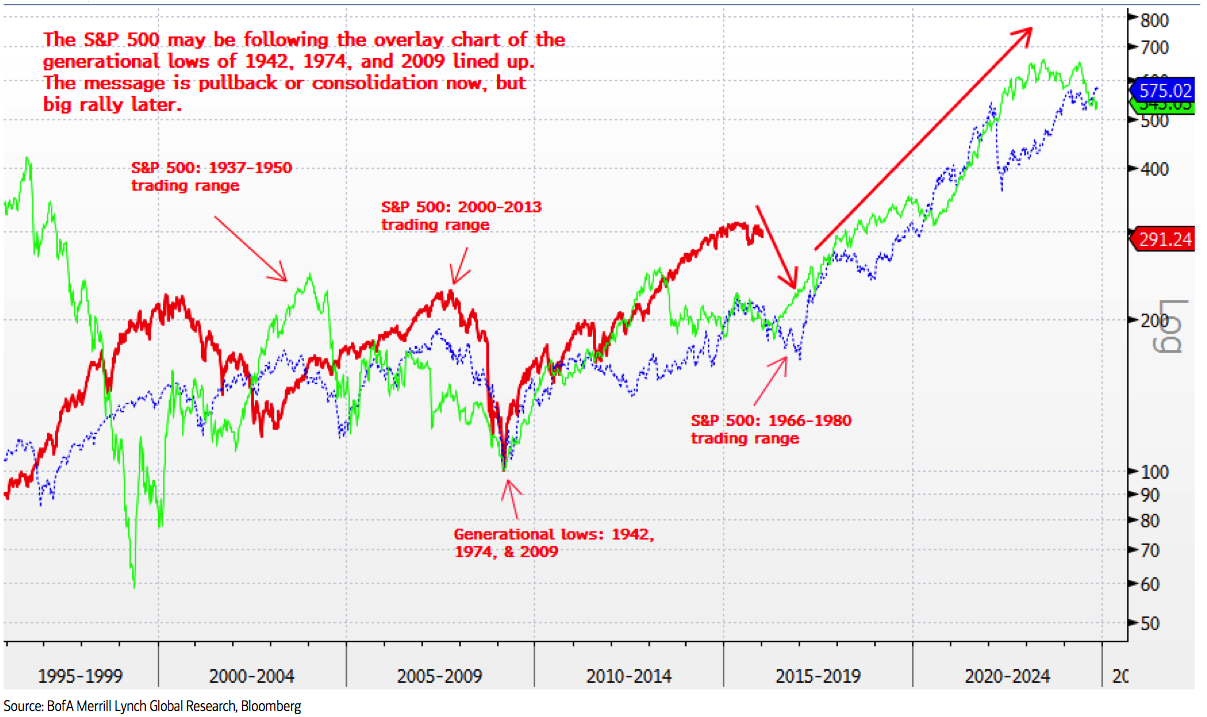From Stephen Suttmeier, Technical Research Analyst, at Merrill Lynch:
The overlay chart of the S&P 500 lined up off the generational lows of 1942, 1974, and 2009 suggested the risk of a cyclical peak (NOT secular) in mid 2015 (high in May 2015 so far) similar to mid 1948 and late 1980 peaks. We view this as a potential cyclical interruption of the secular bull trend, which we believe is in its early innings with potentially 10-15 more years of upside. In our view, a cyclical interruption means the risk of a drawdown of 20% or more but a potential longer-term buying opportunity, akin to mid 1949 and mid 1982, and then another strong cyclical bull market within a secular bull trend.
S&P 500 with the generational lows from 2009, 1974, and 1942 lined up
click for ginormous chart

Source: MLPF&S


What is your take on the influence of emerging markets in what was historically a US driven investment cycle?
Sold to you…
The starting valuation and prevailing interest rates of those “Secular” bull markets matter quite a bit. The market in 2009 wasn’t nearly cheap enough on a value basis, and interest rates lack the headroom to push valuations higher. We’re paying that price now, because at the moment “momentum” is dead (very few sectors remain in an uptrend) and yet equity index prices are not low enough to re-establish long-term value.
For a valuation comparison, see e.g. http://2.bp.blogspot.com/-wJS_iA6Ou_E/URAX4IXZWLI/AAAAAAAABzg/TflQrkwgd6s/s1600/130204-1.jpg
P.S. The returns that actually matter to investors seeking retirement are total returns net of true inflation. Your chart should be labeled to indicate what is being plotted. It appears to only show nominal returns, and is therefore incomplete and misleading.
or sold to you. you have no clue what “real valuations are”. Just don’t talk your book.
I am always really cautious about analogies with the 1974-1982 period due to the high inflation and interest rates during that period that are unlike anything the US saw in the 20th or 21st century markets.
The Fed Funds rate went above 10% at the end of 1978 and didn’t come back down below that for any extended period until late 1982 while peaking at 19%. Meanwhile the S&P 500 dividend yield was only about 4.5%-6% during that period. So the risk-free cash was returning an extra 5% to 10% in cash per year from 1978 through 1982 which is unprecedented before and since. Accounting for inflation and lack of yield compared to the risk-free investment meant that the real drop in the S&P 500 to the trough in 1982 was much more than the 26% the nominal graphs used in technical analysis shows and is much closer to the 50% drop of a major bear market (this shows up in Shiller’s CAPE graphs very clearly). I think that is a key reason that we saw such a massive, long secular bull from 1982 to 2000 with.
So the generational low for nominal values was 1974 but for real inflation-adjusted market value was 1982. Similarly the 1932 bottom wasn’t as bad (still very terrible) as the nominal graphs show because the dividend yield peaked at 10% with much lower Fed Funds interest rates and deflation to boot.
As a result, I view each of the secular bear periods as being their own very distinct animals. While I would be very surprised if we revisited 666 in this market downturn, a 50% drop in the S&P 500 to the 1,000 zone would not surprise me in the least (or we could rebound over the next few months if the economy stays good – 1999-2000 proves anything is possible). The lack of inflation at this time means that the 1980 to 1982 percentage drop is largely irrelevant to me for figuring out how much this current market could drop.
Thanks for ruining this graph, man!
“Happy families are all alike; every unhappy family is unhappy in its own way.”
Leo Tolstoy – opening line of Anna Karenina